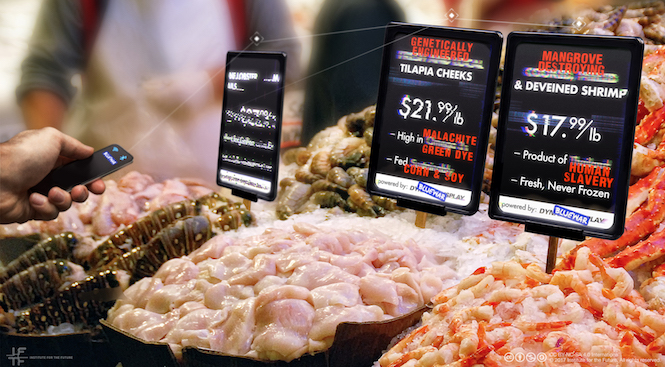Future Now
The IFTF Blog
Artifact from the Future: SURFACE HACKERS
Read coverage in Fast Company »
WHAT: Over the past few weeks, Seattle’s most popular seafood shop has become the target of an attack by the environmental group BlueWar—a hacktivist organization that attempts to expose injustices in the aquatic food system. BlueWar manipulates vulnerabilities in the digital pricing displays, which have been rolled out in nearly every grocery store from London to Lima, that allow grocers to show real-time changes in pricing and product information. Using simple wireless devices, BlueWar paints digital graffiti on these digital surfaces to reveal the ‘true cost’ of seafood. Instead of freshness and nutrition content, customers see labels decrying slave labor in Thai shrimp farms; rampant genetic modification in the tilapia supply; and overuse of antibiotics in most farmed fish—at least until the shop owner resets the displays.
SO WHAT: From grocery aisles to food packaging to pricing displays, our world is already beginning to be covered in digital surfaces and smart objects. In fact, there are more objects connected to the internet today than there are humans walking this earth. In retail environments, digital displays will be new hotspots for collaborative remixing of food narratives, brand marketing, and consumer demands. Controlling narratives will be increasingly difficult, consumers will want to play a role in how the story around their food is told, and culture jammers—or surface hackers—will find new mediums to express their values for our food system. As a result, consumers will have more information available to them, but discerning truth out of all that information will become increasingly difficult. Trust will be highly prized.
Learn more
This particular Artifact from the Future—Surface Hackers—is one of six Artifacts developed in conjunction with our recent Food Innovation report, and might be something you would see over the coming decade as Rewritable Narrative revolutionizes the food system. Read more forecasts and signals about how Rewritable Narrative will be an ingredient for food innovation in the future.

This Artifact from the Future is a snapshot of what might emerge if forecasts about the future materialize. It was developed as part of our Food Innovation: Recipes for the Next Decade report which is a book of recipes on how to create systems-level change across the food system. This Artifact from the Future is an at-a-glance tool for exploring the fundamental question: What is possible?
Like all IFTF’s Artifacts from the Future, this image offers insights into future everyday lives and is intended to give you an immersive look at a possible future change.
How did we get to this future? Signals from today:
A signal is a small or local innovation that has the potential to grow in scale and geographic distribution. Signals are very specific examples that, when clustered together, point to a larger trend or shift. When creating Artifacts from the Future, IFTF combines today’s early signals to tell a new story about what’s possible in the next decade.
Here are some of today’s signals that, when combined, make “Surface Hackers” a possible future:
The central technology in this artifact is the dynamic display. DisplayData is a startup that makes this technology a reality. As costs for smart price tags goes down and adoption goes up, they will afford many new opportunities for customer engagement - and for manipulation.
New technologies often bring new ways to interact with brand narratives. Already, we've seen signals like this troll account pretending to be a Campbell's customer service rep on Facebook in order to run the brand's narrative in a way that an actual customer service rep never could have.
The content of the protest itself is rooted in truth: much imported shrimp has been reveal to be produced using slavery, and human rights campaigners like Verite have run campaigns decrying the practice.
A digital billboard in Cardiff was recently hacked to display offensive images. Public displays, which are rapidly becoming more commonplace, are a big target for hackers, and digital pricing displays will be no exception.
A billboard in Sweden moves beyond passive display and actually interacts with passersby: if it detects that someone is smoking in the area, a man on the billboard coughs in reaction. IoT devices - not just billboards, but packages, displays, street signs, and more - are now designed with built-in basic intelligence that lets them display customized data, just like the display in this artifact shows the customer relevant nutrition information (at least, before it's hacked).
What other signals of this future do you see already happening today? Or, what else becomes possible when these signals combine? We invite everyone to practice being a food futurist and creatively imagining futures that are radically different from the present. Share your ideas with us at foodfutures@iftf.org!




